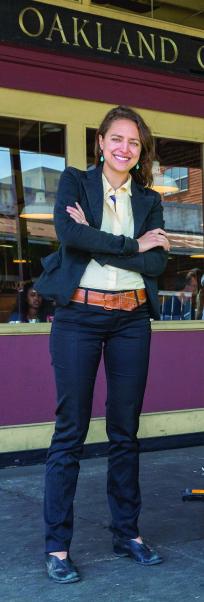
Savlan Hauser’s first interest in cities was an economic one. She grew up in Redding, California, and though, as she explains, it’s “a beautiful spot,” it has, like many American cities, seen its main street decimated by the onslaught of big-box stores at the fringes of town. “When we traveled in the summers,” Savlan recalls, “my sister and I would “busk” (play our fiddles on the streets with our cases open for money from passers-by) in places like Portland, Seattle, and Victoria. The more walkable and vibrant the urban environments were, the more lucrative for us as kid street performers.” That love for vibrant urban environments (and corresponding appreciation for their economic benefits) ultimately led Savlan to a career in urbanism. She studied architecture at the University of California, Berkeley, and worked in design and urban planning in the Bay Area and in Mexico City. She began “inching towards development,” she recalls, “because I was much too interested in dealing with people and the dynamics of a neighborhood to be happy strictly drawing plans.”
How did your busking-to-Burnham trajectory lead you to where you are today?
I’ve been the executive director of the Jack London Business Improvement District, Oakland’s newest and (geographically) largest BID—for four years. I love this work because it’s about people and building community connections. And I get to deal with all scales, from the weeds to the high-rises, and all timeframes, from quotidian maintenance work to the 30-year vision plan. The formation of the district was unique in that it was a grassroots effort, a group of volunteers who convinced a critical mass of their property-owning neighbors to support an assessment on their property for communal benefit. Our mission is quite broad—to create, promote and maintain an inviting environment for people who visit, live or work in the Jack London District. BIDs must be responsive and adaptive to the neighborhoods they serve, though, so each focus is different even though all 10 BIDs in Oakland work on the basics—cleaning, safety and small business support. There’s a pioneering and slightly libertarian spirit on the industrial waterfront side of the 880, and the DIY flexibility of the BID framework seems to suit it well.
What is something we’d be surprised to learn about Jack London Square? And what is your favorite place to spend time here?
The wholesale produce market has been in continuous operation for 100 years as the rest of Oakland has transformed dramatically around it. My favorite place to spend time has to be at Bicycle Coffee, a true community watering hole. The owners are incredibly creative and keep trying new ways to connect with the neighborhood and refine their inventive operation.
We love your story about how you first got interested in cities (through busking!). How did you first learn about SPUR?
I really can’t remember not knowing about SPUR. For me, it has been synonymous with striving to be an engaged, informed urbanist living in the Bay Area.
What’s your favorite city?
From an aesthetic perspective, Istanbul might be at the top. Incredible food, the streets and buildings are architecturally opulent and ooze the geopolitical importance and wealth that was concentrated in that place for centuries. I was there in the middle of winter so it was particularly dramatic to see the ornate architectural details dusted with snow. The most livable city though, with incredibly hospitable public systems, has to be Tokyo.
Favorite book/work of art/film about cities?
William Whyte’s film The Social Life of Small Urban Spaces is mesmerizing and timeless. People-watching is the best.
